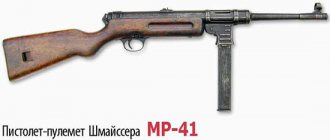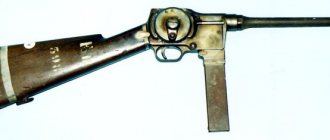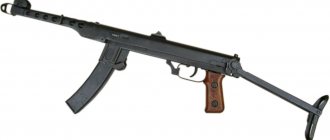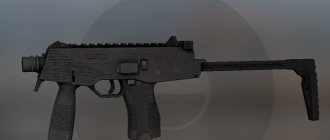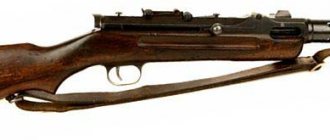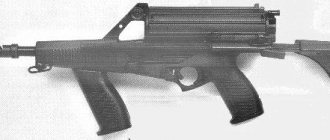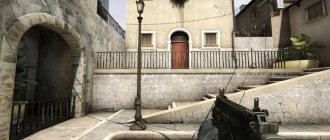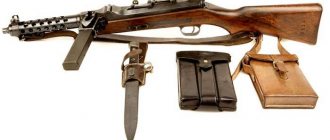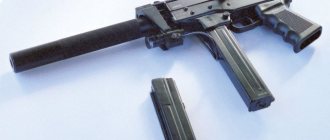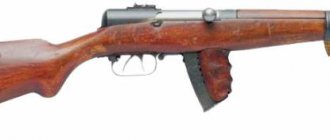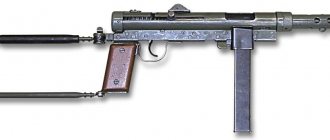| This article requires additional links for verification . |
Type of submachine gun
| Pistol-Mitrailleur de 9 mm, model 1949 (MAT-49) | |
| MAT-49 on display. This weapon has a lowered front handle in the firing position, but no magazine. | |
| Type | Submachine gun |
| Place of origin | France |
| Service history | |
| In service | 1949–present |
| Used | See Users |
| Wars | First Indochina War Suez Crisis 1958 Lebanon Crisis Algerian War Vietnam War Laotian Civil War Cambodian Civil War Portuguese Colonial War Rhodesian Bush War Western Sahara Shaba War II Chad-Libyan Conflict Lebanese Civil War Libyan Civil War [1] Syrian Civil War Northern Mali Conflict [2] ] Civil War in the Central African Republic (2012–present) [3] |
| Production history | |
| Designer | Pierre Monteil |
| Designed by | 1949 |
| Manufacturer | Manufacture Nationale d'Armes de Tulle Manufacture d'armes de Saint-Étienne |
| Produced | 1949–1979 |
| Options | View options |
| Characteristics | |
| Weight | 3.5 kg (7.7 lb) without magazine 4.2 kg (9.3 lb) with 32-round magazine |
| Length | 460 mm (18.1 in) 720 mm (28.3 in) |
| Barrel length | 230 mm (9.1 in) |
| Cartridge | 9 × 19 mm Parabellum 7.62 × 25 mm Tokarev (converted to VPA) |
| Caliber | 9 mm |
| Action | Check valve, open shutter |
| Rate of fire | 600 rounds per minute [4] |
| Feeding system | 20 or 32 rounds 35 rounds (converted VPA) |
MAT-49
was a submachine gun that was developed by the French arms factory Manufacture Nationale d'Armes de Tulle (MAT) for use by the French Army and was first produced in 1949.
Development[edit]
In 1949, after evaluating several prototypes (including a knockdown design from Hotchkiss), the French MAT factory began production of the MAT-49 9 mm submachine gun. The MAT-49 used a machine stamping process that allowed the economical production of large numbers of submachine guns, which were then urgently required by the French government for use by the army, the French Foreign Legion, and the airborne and colonial forces to meet the need for compact weapons. [5]
Production continued in Tulle until the mid-1960s, then moved to Yvoire [12] [13]
Non-governmental organizations [edit]
- National Liberation Army (Libya) [15]
- Zimbabwe African National Liberation Army [16] [ failed verification
] - Viet Minh, [17] known as Tuyin, after the name of the manufacturer (Tulle). [18]
- ETA: Made unlicensed copies of existing weapons in an underground workshop in Mugherra after a police raid. [19]
- Sahrawi Arab Democratic Republic [20]
- FRELIMO [21]
- Seleka [22]
Swedish K
The Kulspruitpistole model 45 submachine gun was developed by the Swedish government in 1945, produced under license in Indonesia, as well as in Egypt under the name "Port Said" and exported to Ireland.
"Smith and Besson", model 76, a licensed version of the Swedish "Carl Gustav" submachine gun, model 45, 9 mm caliber. The American version was popular among CIA officers in Vietnam in the 1960s and 1970s. The same submachine gun, but under the name "Port Said", was produced in Egypt
An almost exact copy of this weapon was produced in the United States in the early 1970s under the designation “Smith and Besson, model 76.” The Model 45 was not in service with any US infantry, navy or police forces, but colloquially referred to as the "Swedish K", it became infamous as the Central Intelligence Agency (CIA) and US Special Forces used it during the Vietnam War. When carrying out covert operations, a version with a silencer was used. The CIA and other services purchased these weapons, bypassing official US military suppliers, and in Vietnam, a person in civilian clothes armed with a Swedish K was automatically classified as a secret agent.
The weapon was equipped with an excellent 36-round magazine with a double-row arrangement of cartridges, very reliable and later copied in Czechoslovakia, Scandinavia and Germany. The weapon itself was also simple and reliable and required only simple care. It was easy to disassemble and clean in the field, and had a quick-change barrel. The butt, located in line with the barrel, allowed accurate fire even in long bursts. The stock folded, making the submachine gun even more compact; loading the magazine did not require special devices.
Links[edit]
- Jump up
↑ Chivers, C. J. (April 20, 2011).
"Inferior weapons hinder rebels in Libya war". New York Times
. - ↑
Rebel Forces in Northern Mali: Documented Weapons, Ammunition and Related Materials, April 2012 - March 2013 (PDF) (Report). Conflict Weapons Research and Small Arms Review. April 2013. - "Important information about weapons in Centrafrique". RFI
(in French). March 16, 2014 - ^ a b c https://world.guns.ru/smg/fr/mat-49-e.html
- ^ a b c d https://www.forgottenweapons.com/mat-49-54-police-submachine-gun/
- ^ a b https://www.smallarmsreview.com/display.article.cfm?idarticles=2508
- ^ ab Leulliette, Pierre, St. Michael and the Dragon;: Memoirs of a Paratrooper
, New York: Houghton, Mifflin & Co. (1964), p. 29 - https://www.5rar.asn.au/weapons/mat49.htm
- https://www.virginia1774.org/DIA-ST-HB-07-03-74.pdf
- https://www.forgottenweapons.com/vietnamese-guns-for-algeria/
- ^ a b Ezell, Edward Clinton (1988). Personal firepower. An Illustrated History of the Vietnam War 15. Bantam Books. pp. 18, 35, 42. OCLC 1036801376.
- ^ B s d e g h i J k l m p o r a QR sec t u V w x y Jones, Richard D. Jane Small Arms 2009/2010
. Jane Information Group; 35th edition (January 27, 2009). ISBN 978-0-7106-2869-5. - De Tessières, Savannah (April 2012). Enquête nationale sur les armes légères et de petit caliber in Côte d'Ivoire: the fight against guns and the fight against violence since the electoral war (PDF) (Report). Special Report No. 14 (in French). UNDP, National Commission to Combat the Proliferation and Illicit Trafficking of Weapons and Small Calibers and Small Arms Survey. p. 97. CS1 maint: ref = harv (link)
- Conboy, Kenneth (November 23, 1989). Laotian War 1960–75. Action 217. Osprey Publishing. clause 15. ISBN 9780850459388.
- ↑
Ackerman, Spencer (April 21, 2011).
"Libya's rebels fight with ancient, useless weapons". Wired
. - https://usacac.army.mil/cac2/cgsc/carl/download/csipubs/ArtOfWar_RhodesianAfricanRifles.pdf
- McNab, Chris (2002). Military uniform of the twentieth century
(2nd ed.). Kent: Grange Books. item 304. ISBN 1-84013-476-3. - "Nhng vũ khí viện trợ đã ra trận cùng QĐVN trong trận Điện Biên Phủ". tintuc.vn
. November 11, 2014 - (in Spanish) Hallan en Francia un viejo arsenal de subfusiles de ETA de los años 70 elmundo.es
- Ignacio Fuente Cobo; Fernando M. Mariño Menéndez (2006). El conflict del Sahara occidental (PDF) (in Spanish). Ministerio de Defensa de España and the Carlos III University of Madrid. p. 69. ISBN 84-9781-253-0. Fuente and Marinho.
- Jump up
↑ Abbott, Peter (2005). Modern African Wars (2): Angola and Mozambique 1961–1974. Oxford: Osprey Publishing. clause 14. ISBN 978-0-85045-843-5. - Touchard, Laurent (December 17, 2013). "Centrafrique: le Soudan at-il armé les ex-Séléka?" . Jeune Afrique
(in French).
Submachine gun "Kedr"
In the early 1970s, Evgeny Dragunov, creator of the famous SVD sniper rifle, designed the Kedr submachine gun, then designated PP-71. The project was shelved, but was revived in the early 1990s. The PP-71 was slightly improved, began to be produced in limited quantities and was put into service with the Russian police.
Instead of the 9mm Makarov pistol cartridge, new, more powerful ammunition was developed. The PMM cartridge retained the same dimensions, but a lighter bullet and an increased powder charge improved its characteristics. In 1994, the design of the “Cedar” was somewhat strengthened and the weapon received the official name of a submachine gun.
ХК54
The West German MP5 submachine gun was introduced in the mid-1960s. under the designation XK54.
The Heckler & Koch MP5 submachine gun is used in six modifications, three of which are equipped with silencers. The miniature size of the MP5K, allowing it to be carried concealed, has ensured its popularity in anti-terrorist units
It received the designation MP5 (“Machinenpistole 5”) after West Germany adopted it for use by the police and border troops. This light-weight weapon with a semi-blowback, air-cooled and magazine-fed is capable of conducting single or continuous fire, as well as firing fixed bursts of two or three shots. The rate of fire is 800 rounds per minute, and the submachine gun is highly accurate.
The weapon is created according to a modular principle and consists of six assembly units, by changing which you can obtain one or another modification upon request. The metal surfaces are phosphated and black lacquered to resist wear and salt water. The MP5 is manufactured or was manufactured under license in the United States, United Kingdom, Turkey, Pakistan, Mexico, Iran and Greece.
usage
Paratroopers 2e REP assault on Kolwezi in 1978.
The MAT-49 saw extensive combat use during the First Indochina War and the Algerian War, as well as the 1956 Suez Crisis.[6][7] The weapon found considerable popularity among airborne and mechanized troops, who valued it for its simplicity, durability, firepower and compactness.[7]
After French troops withdrew from Indochina, the People's Army of Vietnam and the Viet Minh converted many captured MAT-49s to the Soviet 7.62 mm Tokarev pistol cartridge, at the time available in large quantities from the Soviet Union and the People's Republic of China. These redesigned versions featured a longer barrel and a higher rate of fire at 900 rpm.[8][9]
North Vietnam secretly provided the MAT-49 to anti-French occupation groups during the Algerian War after the French abandoned Indochina.[10]
Options
- MAS-48 - prototype version.
- MAT-49 is the main option.
- MAT-49/54 - gendarme version with an elongated barrel and a fixed wooden butt with a sling.[5]
- MAT-49 with suppressor - variant with suppressor.[6]
- K-43 (or MAT-49 M) - a variant modified for the Viet Minh, firing 7.62×25mm Tokarev. It had a longer barrel and a higher rate of fire (900 rpm). Spare parts were still being produced in the 1970s, and the weapons were used by the Viet Cong.[11]
- MAT-49: left and right views; view with the butt retracted and the magazine in a safe position
- Policeman MAT-49/54 model
Review
The MAT-49 had a short retractable cable stock that, when extended, gave the weapon a length of 720 mm (28 in), and the magazine could fold forward parallel to the barrel for parachute jumping or at a 45° angle. an angle therefore allowing the magazine to be carried safely until the magazine returns to a vertical position before opening fire. The barrel length is 230 mm (9.1 in), and the MAT-49/54 is manufactured with extended barrels and a non-retractable wooden stock.[5] In its original state, the MAT-49 fires the 9×19mm Parabellum cartridge, using a single-column 20-round magazine for desert use or a 32-round magazine similar to the Sten magazine.
The MAT-49 is a recoil-driven weapon with a box magazine and a rate of fire of 600 rounds per minute on full auto. The MAT 49/54, a modified MAT-49 made for the police, had two triggers, allowing full automatic fire or single shots, but most were fired only in full automatic mode.[5] Without a magazine, the MAT-49 weighs about 3.5 kg (7.7 lb), making it somewhat heavy for a submachine gun. The weapon includes a safety grip which is located on the back of the pistol grip. The sights are flip-up and L-shaped and are marked for ranges of 50 to 100 meters (55 and 109 yards). Production ceased after the introduction of the FAMAS assault rifle in 1979.
